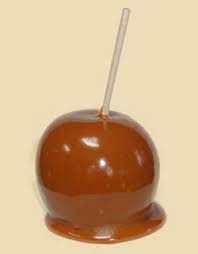A 2014 multistate listeriosis outbreak was linked to consumption of caramel-coated apples, an unexpected and previously unreported vehicle for Listeria monocytogenes. This outbreak was unanticipated because both the pH of apples (<4.0) and the water activity of the caramel coating (<0.80) are too low to support Listeria growth.
 In this study, Granny Smith apples were inoculated with approximately 4 log10 CFU of L. monocytogenes (a cocktail of serotype 4b strains associated with the outbreak) on each apple’s skin, stem, and calyx. Half of the apples had sticks inserted into the core, while the remaining apples were left intact. Apples were dipped into hot caramel and stored at either 7°C or 25°C for up to 11 or 28 days, respectively. Data revealed that apples with inserted sticks supported significantly more L. monocytogenes growth than apples without sticks under both storage conditions.
In this study, Granny Smith apples were inoculated with approximately 4 log10 CFU of L. monocytogenes (a cocktail of serotype 4b strains associated with the outbreak) on each apple’s skin, stem, and calyx. Half of the apples had sticks inserted into the core, while the remaining apples were left intact. Apples were dipped into hot caramel and stored at either 7°C or 25°C for up to 11 or 28 days, respectively. Data revealed that apples with inserted sticks supported significantly more L. monocytogenes growth than apples without sticks under both storage conditions.
Within 3 days at 25°C, L. monocytogenes populations increased >3 log10 in apples with sticks, whereas only a 1-log10 increase was observed even after 1 week for caramel-coated apples without sticks. When stored at 7°C, apples with sticks exhibited an approximately 1.5-log10 increase in L. monocytogenes levels at 28 days, whereas no growth was observed in apples without sticks. We infer that insertion of a stick into the apple accelerates the transfer of juice from the interior of the apple to its surface, creating a microenvironment at the apple-caramel interface where L. monocytogenes can rapidly grow to levels sufficient to cause disease when stored at room temperature.
No growth of L. monocytogenes occurred on refrigerated caramel apples without sticks, whereas slow growth was observed on refrigerated caramel apples with sticks. In contrast, significant pathogen growth was observed within 3 days at room temperature on caramel apples with sticks inserted. Food producers should consider interfaces between components within foods as potential niches for pathogen growth.
Growth of Listeria monocytogenes within a Caramel-Coated Apple Microenvironment
doi: 10.1128/mBio.01232-15; 13 October 2015; mBio; vol. 6; no. 5; e01232-15
Kathleen A. Glass, Max C. Golden, Brandon J. Wanless, Wendy Bedale, Charles Czuprynski
